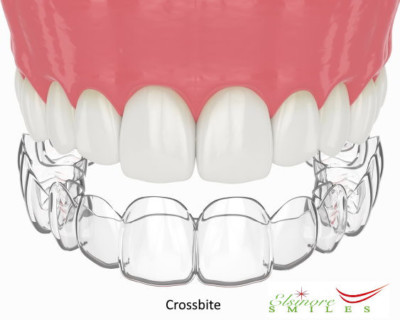Crossbite is frequent in children and does not generally fix itself as they age. The front teeth, back teeth, or both might be misaligned. If left untreated, this malocclusion might cause major problems. Occlusion is the way the upper and lower jaws connect.
What Causes Crossbite? | Types of Cross bites | What issues do Crossbites cause? | How to Treat Crossbite Teeth | Crossbite Vs Underbite
What Causes Crossbite?
 To seal the mouth, the upper jaw must fit within the lower jaw, causing a crossbite. An orthodontist may fix a crossbite in several ways. This might make you self-conscious about your smile and make eating difficult. It may potentially cause TMD (temporomandibular joint disorder) (TMD). TMD may cause jaw joint discomfort and jaw problems.Elsinore Smiles wiill help you find the cause of the problem and avoid TMD.
To seal the mouth, the upper jaw must fit within the lower jaw, causing a crossbite. An orthodontist may fix a crossbite in several ways. This might make you self-conscious about your smile and make eating difficult. It may potentially cause TMD (temporomandibular joint disorder) (TMD). TMD may cause jaw joint discomfort and jaw problems.Elsinore Smiles wiill help you find the cause of the problem and avoid TMD.
Types of Crossbite
There are two types of crossbite in dentistry: anterior and posterior. Anterior crossbite occurs when the front tooth or teeth contacts the lower jaw. Back crossbite occurs in the jaw. Posterior crossbites are more prevalent, occurring in 16% of children vs 4% to 5% of children.
What Issues Does Crossbite Cause?
Crossbite in children is inherited. It is a hereditary condition that the father, mother, or close family members may have had. Other causes of crossbite include thumb sucking, pacifier usage, nail biting, and delayed primary tooth loss. Large tonsils or adenoids may also cause this condition. Dr. Aarti Puri can diagnose the cause of your crossbite and recommend solutions. Read about tongue thrust.
Effects
An open bite malocclusion causes dental troubles, bruxism, health concerns, and psychological issues. Missing teeth, gum disease, and tension on the jaw muscles may cause persistent jaw disorders, neck, shoulder, and back discomfort if they are not corrected.
Early diagnosis and treatment of this condition is critical to preventing future dental and bone issues. This condition is not treatable by medicine and requires orthognathic surgery (one of several medical specialties) to rectify. Crossbite correction with invisalign is simpler and faster. You can likely get veneers for crossbite if your teeth are slightly or moderately crooked.
How To Treat A Crossbite
The optimal time to treat this type of malocclusion is in childhood or adolescence. Adults may be treated, although it takes longer than with children. According to the American Dental Association (ADA), the dentist must ensure that the tooth may move freely in crossbite and that the bite can be opened to allow movement. The patient must additionally wear an orthodontic device to be treated.
Maxillary Expander
An orthodontist applies a device to the palate and upper teeth. Using a particular key on the gadget, the technology progressively opens the upper palate. This gadget works well in children with developing palates.
Removable Expander
Adults use this gadget to gradually broaden their upper palate. It is generally worn every night until desired.
Braces Treatment
Braces are a permanent remedy for crossbite and other bite problems. During this procedure, dental braces are utilized to move the teeth and jaw. After braces treatment, a retainer (orthodontics) is used to keep the teeth in position.
Surgical Method
After the patient wears a custom-made gadget, the surgeon will purposely break the jaw bones. Unlike palate expanders, surgery allows for a larger expansion.
Crossbite Vs Underbite
A crossbite occurs when your teeth do not line up correctly when you shut your mouth. In a crossbite, the bottom teeth are broader and sit outside the top teeth. Schedule an appointment or visit for more consultation.
An underbite is a type of malocclusion where the lower teeth extend farther away than your upper teeth. This usually results in the misalignment of the jaw known as Class III malocclusion. See overbite for more details.
